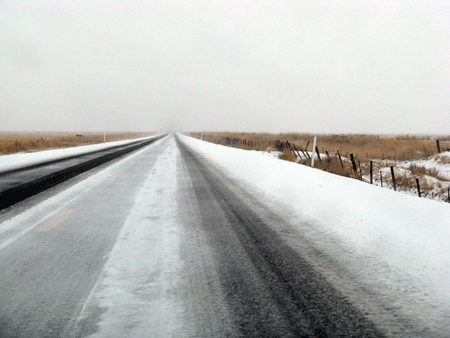
View from Empire Bluff, Sleeping Bear Dunes, Michigan
oil on maple, 24 x 18 inches. more… »
Archives for landscape
Shapes
Clay and Lichen
A documentary on the progress of a layer of clay descending a dune

Oil on maple, 24 x 18 inches
For more than a decade, we have been watching a layer of clay slowly descending a slope of the Empire Bluff. Usually, the ‘necklace’ stands out as a vegetation-free band. But on a winter day, it was nicely accentuated by snow.
I have given up walking around this aspect of the bluff out of concern that there suddenly could be a slide of clay. Two decades ago, the north-western most tip of the dunes at Glenhaven caved in after I walked there with my dog. Since then, I have grown to respect the forces of nature here.
Wet Spring
A natural riverside park were I went to relax – a long time ago.
Post-Painting Depression
I’m back in Portland, Oregon, from my six-week Nevada sojourn. But I haven’t unpacked my big linen canvases yet. I am almost afraid to do so, fearing that they are completely banal, hence total failures (banality is worse for me than bad).
In part, this reluctance has to do with various coming home challenges — burst pipes, unreliable contractors, relatives using the house in unexpected and unnerving ways. But in part, it’s simply because I don’t know what I did, although I am fairly certain I did not manage to un-orient, and my feeble attempts merely feel like they may be so feeble as to look feeble-minded.
Well, you see where I am. I began last February and March, 2009, living with the desert and Beatty, Nevada, painting small masonite panels, getting to know the territory and its inhabitants. This November sojourn, however, was more limited and almost entirely devoted to the Amargosa, which became more and more fascinating as I spent 6-8 hours a day, alone with the scene, for the full month of November.
So here are photos of the seven panels, plus the full panorama. These were taken as the panels were still on the wall of the Red Barn, under under limited lighting conditions. The exception is the full panorama, which was lit andphotographed by professional photographer, David Lancaster.
I am showing these in part to bolster my own sense of dignity and/or bravado.
 Unoriented Amargosa (panel 1, east), 4′ x 5′, oil on linen, 2009
Unoriented Amargosa (panel 1, east), 4′ x 5′, oil on linen, 2009
Unoriented/ Oriented: Painting the Desert
This is a double posting, ruminations from Day 29 of my Residency at the Goldwell Open Air Art Museum. So if you’re reading the residency journal, this is all old news. And it’s really an essay ruminating about the experience during the last few days of our stay. I will almost certainly publish images of the final result of the painting when there is a final result. But this is mostly just thinking, ruminating, rummaging.
I told Jer this morning that I should be able to “finish” these canvases in another two days. Tonight I’m not so sure. But I’m not going to show any more photos of them until I’m fairly confident that I’ve done as much as I can see to do. The panorama does have a name, which for me means it’s close to being done. I’m calling it “Unoriented: The Amargosa Desert.”
I spent an hour this afternoon (when my eyes and brain could no longer deal with painting itself) reflecting on what I had wanted to achieve and what factors were involved in getting me to this stage of the work. I wrote these “reflections” down in my notebook, knowing that by this evening I’d be totally clueless as to what I was thinking at 2:30 PM.
It’s very nice to have a handsome notebook, even though when I read back through this month’s entries, I often haven’t a clue what I was talking about.
Color — some notions

Gerhard Richter, 1985, 57.4 cm x 86.4 cm, Oil on paper
The Henri Art Magazine (written, I think, by several authors) has a fascinating continuation of a discussion of color, “Color: Simulation,” published on Wednesday Nov. 4, 2009.
The author discusses how the perception of color has changed with technology, the technology that presents any color you want: directly out of the can (reducing the need to use traditional techniques to create luminescence or brilliance by direct observation and experience); and then, further “enhancing” and changing color as we know it, technology can produce a pure physics of color through light technologies (as seen on the computer screen.) This, he insists, has produced color as desire, as consumer directed, and loses color as personal and emotive.
I can’t do justice to the writer’s observations; you’ll need to read them yourself. And I’m not sure the polemic need be as strong as it is.
But I was reminded of Steve’s black and white photography, (also here, on A&P) and along with thinking that Steve’s work clearly transcends point-and-shoot photography of the digitized masses, I suddenly understood how the black and white refuses the seduction of the digitized web versions of color.


